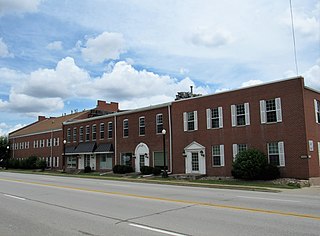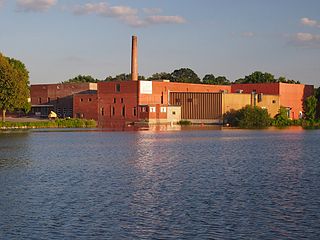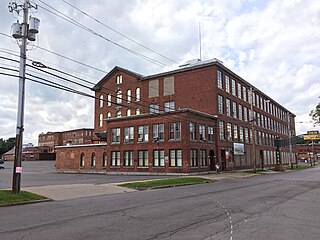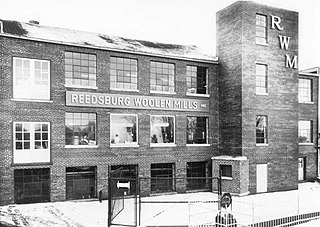
Peace Dale is a village in the town of South Kingstown, Rhode Island. Together with the village of Wakefield, it is treated by the U.S. Census as a component of the census-designated place identified as Wakefield-Peacedale, Rhode Island.

Wheelockville is a village in the town (township) of Uxbridge, Massachusetts, United States. Part of the village centering on Mendon and Henry streets is listed on the National Register of Historic Places as the Wheelockville Historic District. Wheelockville appears on the Blackstone U.S. Geological Survey Map. The Village receives municipal services from Uxbridge, for fire, police, EMS, School district, public works, and other services. Worcester's Judicial District includes Uxbridge District Court. The geography of Wheelockville includes several other distinct mill villages, including: Hecla and Elmdale.

The Waucantuck Mill Complex was a mill complex in Uxbridge, Massachusetts. Despite its 2010 demolition, it is still listed on the National Register of Historic Places. The original Luke Taft Mill, built in 1824, on the West River was very close to the present site of the Waucatuck Mill complex. The Waucantuck complex was planned for a condominium and retail complex, underway in 2009. Both are very close to and virtually part of the Wheelockville District, where the Stanley Woolen Mill was built in 1852. Wash and wear fabrics were first developed at this mill in the 20th century. Products were produced under the name of "Indian Head". In the 1960s the former holdings of American Woolen Company were eventually acquired by a company by that name in Uxbridge, MA. Originally the Uxbridge Worsted Company had proposed a buyout of American Woolen to become America's largest woolen conglomerate. The Town of Uxbridge was synonymous with the textile industry and its earliest and later developments.

The Hanora Mills are a historic textile mill complex the center of Woonsocket, Rhode Island.

The Central Village Historic District is a historic district in the Central Village area of Plainfield, Connecticut that was listed on the National Register of Historic Places (NRHP) in 1991. It encompasses a late 19th-century historic mill village, including a small commercial center where Connecticut Route 12 and 14 meet, a cluster of architecturally distinguished buildings built by mill owners and managers, and a collection of mill worker housing units. It includes the Plainfield Woolen Company Mill, which is separately listed, as well as archaeological remnants of other mill infrastructure. It also includes Plainfield's old town hall and high school. Other architecturally prominent buildings include the c. 1855 Italianate mansion of mill owner Arthur Fenner, and the 1845 Greek Revival Congregational Church.

Watkins Mill, in Lawson, Missouri, is a preserved woolen mill dating to the mid-19th century. The mill is protected as Watkins Woolen Mill State Historic Site, which preserve its machinery and business records in addition to the building itself. It was designated a National Historic Landmark and added to the National Register of Historic Places in 1966 in recognition for its remarkable state of preservation. The historic site is the centerpiece of Watkins Mill State Park, which is managed by the Missouri Department of Natural Resources.

The Norad Mill is a historic mill located in Braytonville, North Adams, Massachusetts. It is the oldest mill complex in North Adams that has not had its exterior significantly altered, making visible much of its Italianate styling.

The Ashland Mill Tenement is a historic tenement at 141-145 Ashland Avenue in Southbridge, Massachusetts. Built about 1835, this unassuming rowhouse is one of the oldest documented factory-related buildings in the city. It was listed on the National Register of Historic Places in 1989.

The Hamilton Woolen Company Historic District encompasses the well preserved "Big Mill" complex of the Hamilton Woolen Company, built in the mid 19th century. Located at the confluence of McKinstry Brook and the Quinebaug River in central Southbridge, Massachusetts, the complex consists of a cluster of mill buildings and a rare collection of 1830s brick mill worker housing units located nearby. The district was listed on the National Register of Historic Places in 1989.

Hallville Mill Historic District is a historic district in the town of Preston, Connecticut, that was listed on the National Register of Historic Places in 1996. Contributing properties in the district are 23 buildings, two other contributing structures, and one other contributing site over a 50-acre (20 ha) area. The district includes the dam that forms Hallville Pond, historic manufacturing buildings and worker housing, and the Hallville Mill Bridge, a lenticular pony truss bridge built circa 1890 by the Berlin Iron Bridge Company.

Woolen Mills Chapel is a historic chapel located at 1819 E. Market Street in Charlottesville, Virginia. The Late Victorian building was constructed in 1887.

Shields Woolen Mill is located along the edge of the Mississippi River in Davenport, Iowa, United States. It has been listed on the National Register of Historic Places since 1983. The building has been repurposed as commercial and office space called One River Place.

Grand Forks Woolen Mills is a building located on the corner of Third Avenue North and North Third Street in Grand Forks, North Dakota, designed by architect John W. Ross. A three-story construction approximately 50 feet (15 m) by 100 feet (30 m) in size, it is recorded as being built in 1895. Constructed of brick, the architectural style has been described as Commercial vernacular.

The Faribault Woolen Mill Company is a textile manufacturing company in Faribault, Minnesota, United States, that produces and sells wool blankets and other woolen products. Its products included ingeo, cotton, acrylic and wool bed blankets, pillows, mattresses, pads, and baby blankets, and wool, ingeo and blend throws. The company primarily serves various enterprise sectors. It offers its products through its store in Faribault and nationwide through retailers.

The Hilgen and Wittenberg Woolen Mill is located in Cedarburg, Wisconsin, United States. It was built in 1864 by Frederick Hilgen, Diedrich Wittenberg, and Joseph Trottman to produce yarns, blankets, and flannels. In the 19th Century, it was the only mill of its kind west of Philadelphia.

The Sawyer Woolen Mills are a historic textile mill complex at 1 Mill Street in Dover, New Hampshire. Built in stages between 1873 and 1939, the mill complex is one of New Hampshire's most intact mill complexes, reflecting multiple architectural styles which were retained by addition to the complex rather than by the demolition of older buildings. The mills were listed on the National Register of Historic Places in 1989.

Globe Woolen Company Mills is a historic woolen mill complex and national historic district located at Utica, Oneida County, New York. It encompasses four contributing components of an intact mill complex: the Woolen Mill Grouping (1872-1873); Storehouse #2 (1872-1873); Storehouse #3 (1872-1873); and the Worsted Mill Grouping (1886). They include four-story mill buildings, attached company office, and two remaining store houses. The buildings are constructed of red brick and have Italianate style design elements. After the mill closed in the 1950s, the buildings were reused for college classrooms and later as offices.

The Bridgewater Woolen Mill, now more commonly the Bridgewater Mill Mall, is a historic textile mill complex on United States Route 4 in Bridgewater and Woodstock, Vermont. With an textile processing history dating from 1828 to 1975, it was one of the state's longest-lived textile operations, and was a mainstay of the local economy during that period. It has since been repurposed into a shopping center. It was listed on the National Register of Historic Places in 1976.

Decorah Woolen Mill, also known as the Meritol Building or Decorah Tire Service, is a historic building located in Decorah, Iowa, United States. The mill was originally constructed in 1867, and was operated by various owners in the years to come. They included the Decorah Glove and Mitten Works who operated in the building the same year, 1908, that it was struct by a tornado. The third floor sustained damage, and they continued operations here. By 1919 they were no longer in business here and the American Drug and Press Association, the Meritol Company, bought the building and expanded it. They made pharmaceuticals and patent medicines, and went bankrupt in 1932. Various other companies operated from here until 1955 when Decorah Tire Service took over. The building was individually listed on the National Register of Historic Places in 2001. The property was developed into a 15-unit apartment building, which opened in 2002. In 2017 it was included as a contributing property in the Decorah Commercial Historic District.

The Reedsburg Woolen Mill was a historic woolen mill along the Baraboo River in Reedsburg, Wisconsin. The woolen mill was built in 1891 and lasted until 1968, when most of it burned down, leaving the office building intact. It was added to the National Register of Historic Places in 1984.





















